TECH1002 - Studies in Media Technology
Directed Study - Week 8
Task 1
This week's directed study task is to re-cap some of the topics and ideas that have been covered over recent weeks in this module. Work your way through this learning material.
Task 2
Once you have worked your way through this learning material you should complete the follow-up test. The follow-up test can be found in the Directed Study folder on Blackboard. The test will help you to assess your knowledge and give you an idea of the areas you may need to read again.
This is a formative test and the results from this will not be added to your overall module grade.
The Three Cs of convergent media
Flew (2008) talks about the Three Cs of convergent media. If two Cs are content (media) and communications, what is the third?- CD-ROMS
- Computing
- Convergence
- Criticism
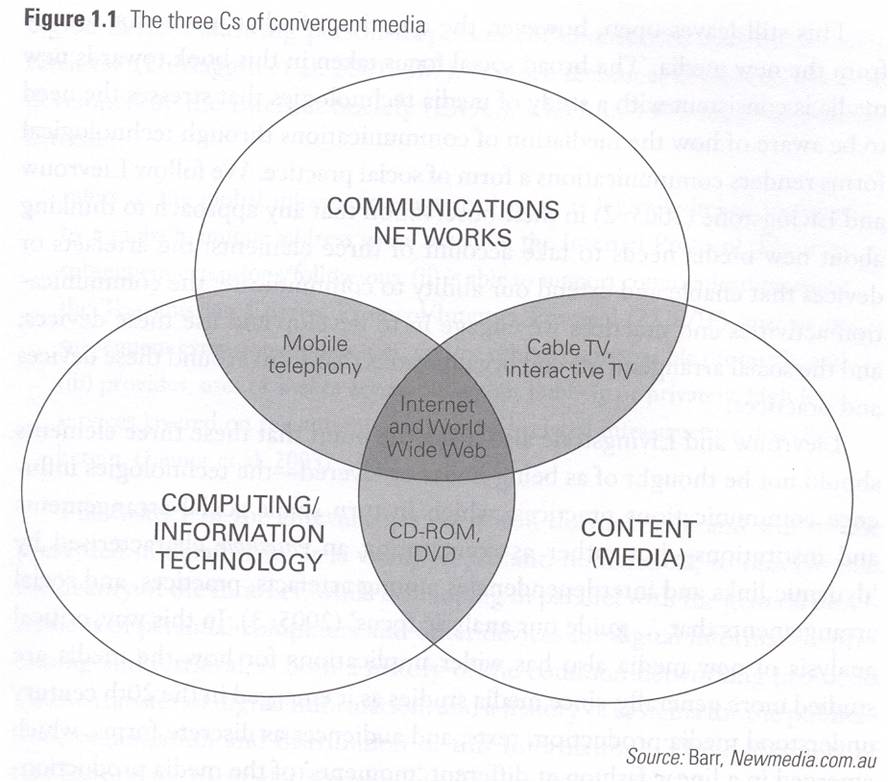
Computing completes Flew's three Cs of convergent media.
The diagram shows how the three Cs relate to one another.
Convergence
Convergence and new media is discussed by Flew (2002 and 2008), Lister et al. (2003) and Jenkins (2006), but what is convergence?- The meeting, or coming together of media and communication technologies
- It may be thought of as one of the defining characteristics of new media
- A particular but not unique consequence of digital technology, and media production and distribution, particularly through computing technology
All of these answer the question "what is convergence?"
Jenkins (2006) says that we "are now entering convergence culture" (p.23) "...where old media and new media collide, where grassroots and corporate media intersect, where the power of the media producer and the power of the media consumer interact in unpredictable ways" (pp.259-260).
Convergence culture
In his book Convergence Culture (2006) Henry Jenkins says that convergence cultures are the "technological, industrial, cultural, and social changes in the way that media circulates within our culture" (p.282). He says a Convergence Culture is "a situation in which multiple media systems coexist and where media content flows fluidly across them. Convergence is understood here as an ongoing process or series of intersections between different media systems, not a fixed relationship" (p.282).
Jenkins (2006) suggests that there are three parts to convergence culture. These are convergence, collective intelligence and participatory culture.
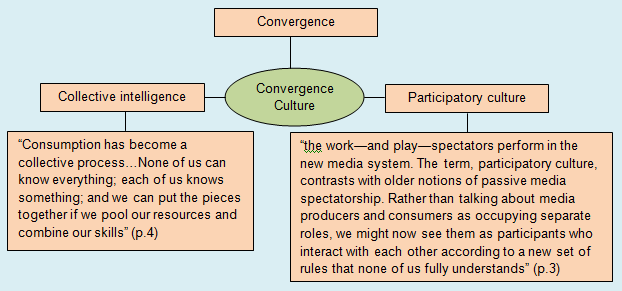
Original purpose of computers
What was the original purpose of computers?- Communication with others
- Creation of patterns on fabric
- Performing mathematical calculations

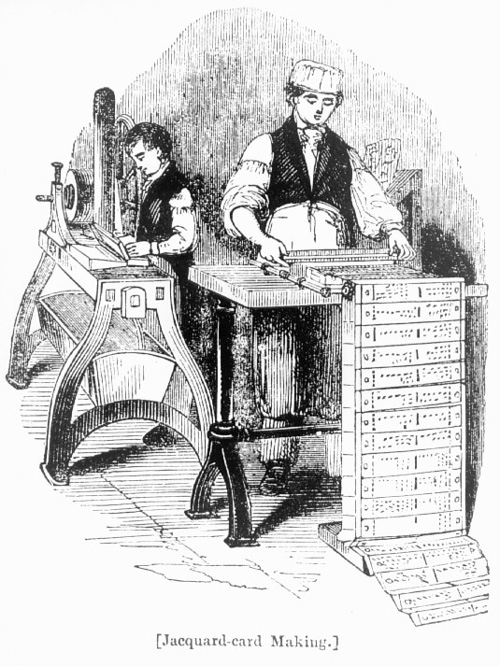

The original purpose of computers was to perform mathematical calculations.
Today computers are used for a range of activities but rarely calculations.
Although we often use computers as communication devices now this was not their original purpose. In 1801 Jacquard loom punch cards were used for storing the details of patterns, but this was not the original purpose of computers.
History of computers
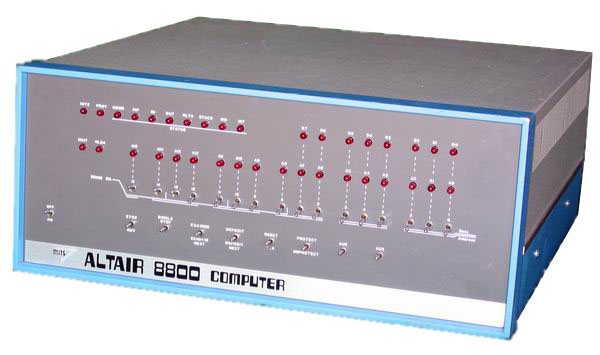
1837 - Charles Babbage works on the Analytic Engine. It is generally thought of as the first programmable mechanical computer.
1842 - Ada Lovelace mechanically translates a short written work, she is generally regarded as the first programmer.
1854 - George Boole writes An Investigation of the Laws of Thought, he is generally recognised as the father of computer science.
1937 - Alan Turing proposes a "Universal Machine" capable of "computing" any algorithm.
1953 - IBM introduces the 701, the first commercially successful computer.
1974 - Hobbyist Ed Roberts built an Altair 8800. This showed the possibility of personal computing and was the first commercially available personal computer (PC). It was based on a single-chip microprocessor from Intel.
The picture shows an Altair 8800.
Example of what?
‘The Crossed Bison’ of the Lascaux Cave Paintings (c. 15,000-13,000BC) are an early example of what effect? In this example the effect is created through the medium of paint.- Stereovision
- Holography
- Depth perception
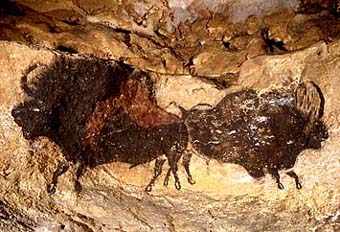
‘The Crossed Bison’ of the Lascaux Cave Paintings (c. 15,000-13,000BC) are an early example of depth perception.
These paintings show the crossed-hind legs show perspective. This type of skill wasn’t seen again until the 15th century
Terms related to 3D vision
Stereovision = Generally we have two eyes that give us two views. The two views are fused by brain, this is stereovision. Stereovision allows us to experience the world in three dimensions (3D).
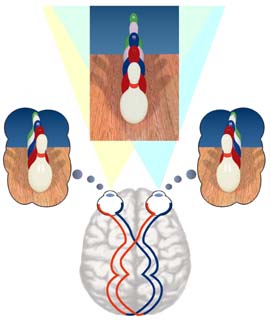
Depth perception = Depth perception is the ability to see the world in 3D. You get various depth cues that help with your depth perception. Binocular depth cues (with both eyes) are known as stereopsis. If you can only see through one eye you can still make a judgement of depth based on depth cues.
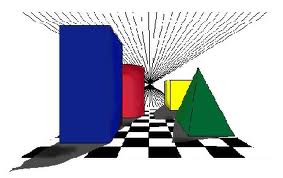
3D images = When an illusion of depth is experienced by the viewer they are looking at a 3D image. 3D images are images that appear to have height, width and depth are three-dimensional (3D). If there is no depth then the image is two-dimensional (2D).
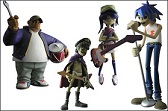
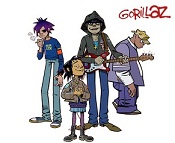
Anaglyphs
Anaglyphs are 3D images that require passive lenses in order to view the image and see the 3D effect. Anaglyph glasses have two coloured lenses, one red and one cyan. Each lens prevents the eye from seeing parts of the image, whilst the other lens lets the eye see those parts.
Red lens = The red lens allows only red light to pass through it.
Cyan lens = The cyan lens allows any light to filter through that is not red.
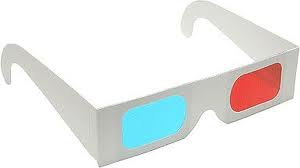
3 technological mediations of cinema
Which of the following is not one of the 3 technological mediations of cinema?- 1895 – public show
- post-WW2 television, VCR, DVD, ‘home cinema’ - convergence
- hiring the cinema for private viewing
- computer, internet, web, digital video - convergence
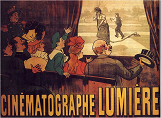

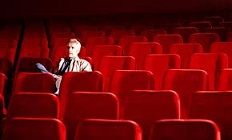
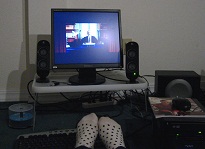
hiring the cinema for private viewing = This is not one of the 3 technological mediations of cinema.
Digital post-production important concepts
When thinking about digitial post-production there are a number of concepts that are important. Here are some of those concepts and their definitions.
Hyperrealism = the effect of the simulation of verisimilitude and photo-realism within animated films, it can also be thought of as an artistic style characterised by highly realistic graphic representation
Simulation = an imitation. Simulations are 'fakes', because a reality is experienced that does not correspond to any actually existing things
Photo-realism = the imitation of the visual appearance of the world as captured by photography and cinematography
Verisimilitude = the imitation of the visual appearance of the world as it appears to the human eye
Mechanical special effects
Mechanical special effects are also known as practical or physical effects and happen during the shoot.

Scale models, like this from the film Titanic (1997), are used for some shots in films that may be unachievable any other way.
Mechanical special effects
Mechanical special effects are also known as practical or physical effects and happen during the shoot.
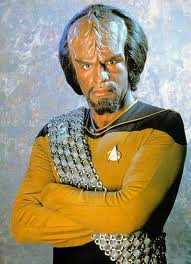
Prosthetic make-up acts as a special effect. It uses prosthetic sculpting, molding and casting, as well as advanced cosmetic effects.
Photo-realism
Which of the following are ways to describe photo-realism?
- Photo-realism is an aesthetic strategy that involves simulating the visual replication of photography and cinematography
- Photo-realistic images are not produced by photographic techniques, but they look like they have
- Photo-realistic images imitate reality as a photograph, not as a human visual experience
Answer
All of these are ways to describe photo-realism.
Consider a computer game, if it uses photo-realism the images presented look like they have come from a camera. If the game uses non-photorealistic rendering the scenes have a more artistic feel, as if they have been drawn or painted.

Shrek Aesthetic
www.shrek.com says that Shrek features what computer graphic (CG) artists consider to be the "Holy Grails of CG Animation".
Use the image to find out more about what the CG animators attempted to achieve and were able to do in Shrek.
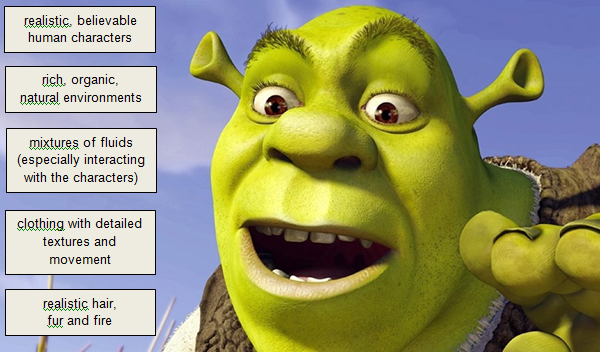
Radio and POR
Radio is undergoing digital continuity and transformation (DAB and internet). What does the acronym POR stand for?
- Pirate Organised Radio
- Personalised Online Radio
- Pretty Original Recordings
- Podcasting Online Radio

Personalised Online Radio (POR) is a way of listening to radio via online streaming services.
Development of radio
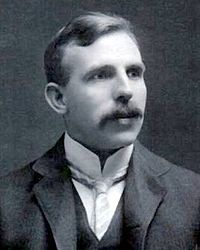
A number of people were involved in the invention, creation and development of the radio and radio technologies.
Who was involved with these technological developments?
Baviera = Correct Julio Cervera Baviera collaborated with Marconi in 1899 to resolve wireless telegraph difficulties.Bose = Correct Jagdish Chandra Bose demonstrated the use of radio waves in 1894.
Caroline = Try again Caroline, or Radio Caroline, is a pirate radio station that started broadcasting in 1964.
Lodge = Correct Oliver Lodge used wireless to send Morse code, the invention of wireless telegraphy in 1894. Lodge demonstrated how a receiver could 'tune' to a particular transmitting station in 1897.
Marconi = Correct Guglielmo Marconi was an Italian inventor who came to England in 1896. In the same year he worked on wireless experiments for British post office. A year later he established a radio station on Isle of Wight. In 1898 Marconi opened radio factory in England and in 1901 he sent Morse code signal across Atlantic. Marconi put wireless communicators on ships and enabled first transatlantic radio service.
Moyles = Try again Chris Moyles is a well-known radio presenter on BBC Radio 1.
Popov = Correct Alexander Popov demonstrated transmission and reception of radio waves in 1895, using a coherer (early radio signal detector).
Rutherford = Correct Ernest Rutherford worked with wireless waves for the signalling and detection of electromagnetic waves over distance, from 1895 onwards.
Tesla = Correct Nikola Tesla was a Serbian inventor, electrical and mechanical engineer. In 1891 he started radio research and in 1893 demonstrated wireless radio communication. Tesla found ways to produce reliable radio frequency electrical currents, demonstrated principles of radio and transmitted signals over long distance.
First radio broadcasts
Which of the following are examples of 'firsts' in radio broadcasting?
- 1906 – Reginald Fessenden broadcast voice and music to ships from Massachusetts
- 1920 – concert by Dame Nellie Melba heard throughout Europe and parts of North America
- 1920 – first broadcast in USA was the results of the US Presidential election
- 1922 – first BBC radio transmission
- 1922 – BBC broadcast first orchestral concert, first dance music, first radio talk programme and first news bulletin
- 1922 – BBC broadcast first radio play “The truth about Father Christmas”, and first religious programme

Answer
All of these are examples 'firsts' in radio broadcasting.